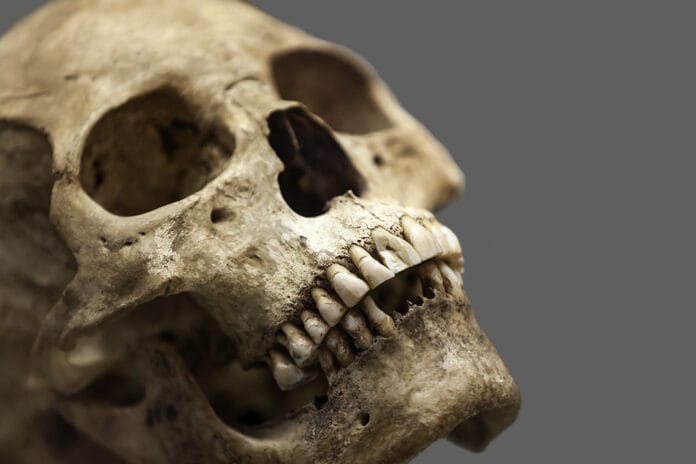Dentistry has been abuzz with airway and tongue/lip ties, forward head posture, and the like. Some dental professionals believe this is all due to the change in our diets. Admittedly, this likely played a role in the shape of our jaws.
However, if you are of the belief that this is the sole reason our faces have changed, I would like to challenge you to look at the bigger picture. Dietary changes are only a small part of the overall evolution of the human skull. There are so many more factors to consider.
Full disclosure: I was prompted to write this article due to fellow dental hygienists’ suggestions for books on social media. Some books only explore the idea that dietary changes are the reason for jaw changes. Although dietary changes certainly played a role, hormonal changes, genetics, increased intelligence, and speech are also implicated.
These changes were not isolated to the jaws. They encompassed the entire skull. Ignoring the changes of the skull in its entirety makes this complex evolution too simplistic.
Hormonal Changes
Some studies indicate the change in food from a hard diet to a softer diet likely played a role in the evolution of the skull. There is also evidence that a change in the level of testosterone played a role in reshaping the skull and making social networks among humans more tolerable and less antagonistic.1
Though the invention of agriculture was 10,000 years ago, it was before this that changes to the human skull began to occur. In a study of 1,400 ancient and modern human skulls, there is evidence that testosterone levels began to drop some 50,000 years ago. This is evidenced by the more feminine features of the skulls.1
It is also postulated that the drop in testosterone accompanied cooperation, complex communication, and modern culture. Higher testosterone levels would cause more aggression in humans and be counterproductive to the development and success of modern culture among humans.1
Changes that were evident included less pronounced brow ridges, rounder heads, shortening of the upper face, and an overall more feminized skull. These traits generally reflect a reduction in the action of testosterone, but it is unknown if lower circulating levels or fewer receptors were the reason for lower testosterone levels.1
Around the time of these changes in the human skull, there is also evidence of the production of bone and antler tools, heat-treated and flaked flint, projectile weapons, grindstones, fishing and birding equipment, and a command of fire. The driving factor for these cultural improvements and hormonal changes is not clear. Some hypothesize that it could have been a brain mutation, cooked foods, the advent of language, or just population density.1
No matter the cause, it is clear that skulls began to change in shape some 40,000 years before the invention of agriculture, indicating diet changes alone are not solely responsible for today’s human skull shape.
Genetics, Improved Intelligence, and Speech Development
When comparing the skulls of ancient hominins and modern humans, it is easy to discern a clear difference in the shape of the skull. While their endocranial volumes are similar, they possess distinct endocranial shapes.2
Modern humans present with a more globular skull, while ancient hominins had an elongated skull. Notably, the modern human’s globular braincase has a round, expanded posterior cranial fossa housing the cerebellum and more pronounced parietal bulging. The most significant dissimilarities between the two groups are thought to lie in the cerebellum. This evolution of the skull led to higher-functioning brains, which contributed to subtle genetic changes in the human genome.3
Research by Kochiyama et al. suggests that the cerebellum underwent rapid evolutionary changes in both humans and great apes.4 However, a comprehensive analysis based on recent data reveals that the distinctions extend beyond the cerebellum. Modern humans have relatively larger areas in the prefrontal cortex, occipital, and temporal lobes compared to Neanderthals.3
Interestingly, the bulging parietal bones in modern humans do not correlate with increased surface area, suggesting that other, likely subcortical, brain regions have been reorganized.3
We know that the prefrontal cortex “regulates our thoughts, actions, and emotions through extensive connections with other brain regions.”5 The prefrontal cortex allows for executive function and self-regulation. This enables modern humans to plan, focus attention, remember instructions, and juggle multiple tasks successfully. These skills are necessary for modern cultures and human success.6
The occipital lobe allows for “visuospatial processing, distance and depth perception, color determination, object and face recognition, and memory formation.”7 As you can imagine, the evolution of the occipital lobe led to better hunting and gathering, nurturing of the young, and creation of modern societies.
The temporal lobe is associated with speech perception and production, hearing, and episodic memory. This was essential for the development of language and cooperation. Without the evolution of the temporal lobe, our ability to create and understand language would be nonexistent.8
Several single-nucleotide polymorphisms have been identified through DNA evaluation of modern humans and ancient hominins. Researchers discovered that the genomic evolution of the RUNX2 gene is likely responsible for the evolution of the bone structure of the modern human skull. RUNX2 is the driving factor in skeletal development in vertebrates, and it plays a specific role in craniofacial and skull morphogenesis.2
Nonetheless, the process of braincase shape formation, which lends to altered skull shape, is influenced by a complex interplay between cranial bone growth, facial size, and the pace of neurodevelopment. In modern humans, globularity develops during perinatal stages, driven by the rapid expansion of the brain. This development theory posits that endocranial globularity mirrors evolutionary shifts in early brain development.3
Changes in Tooth Morphology
Though the evolution of the skull shape is fascinating, the morphology in the teeth is even more fascinating. Around 7 million years ago, skulls and jaws were elongated, canines were very pointy, and arches were more parallel and narrow than the curvature we see today. Around 5.5 million years ago, canines began to appear smaller. Around 3.5 million years ago, widening of the palate was observed where the molar region was farther apart than the anterior teeth.9
Around 1.8 million years ago, our ancestor’s canines became more recognizable as they appeared shorted and blunted, similar to what we see today. Additionally, there was a noticeable change in jaw shape. The jaw became much shorter, and the rounding of the arches was evident. By 250,000 years ago, our direct ancestors developed very short jaws and a pointed chin for added strength. To accommodate the teeth, we see the teeth becoming smaller in size and arranged in a tightly parabolic arch, with faces that are now vertical rather than elongated.9
Comparing Then and Now
| 7 Million Years Ago | Now | |
| Dental arches and tooth rows | · Teeth were arranged in the jaw in a rectangular or U-shape
· A diastema was present next to each canine tooth. These gaps provided space for the opposing canine to fit into when the jaw was closed. In the maxilla, the gap was on the mesial side of the canine. On the mandible, it was on the distal. |
· Teeth are arranged in a parabolic or rounded arc shape
· There is no diastema next to the canines |
| Jaw and face profile | · The jaw was long, which resulted in a projecting face profile
· There was no chin |
· The jaw is very short, so there is almost no projection of the face
· A pointed chin is present |
| Teeth | · Incisors were relatively large
· Upper incisors were broad and projected outward · Canines were very long, pointed, and much larger in males than in females · Molars were large · Premolars and molars had high cusps · Teeth were covered by a thin layer of enamel |
· Incisors are relatively small
· Incisors are narrow and quite vertical · Canines are short, relatively blunt, and similar in size in both males and females · Molars are small, and often, third molars become impacted due to the shortening of the jaw · Premolars and molars are relatively flat with low, rounded cusps · Teeth are covered by a thick layer of enamel |
Adapted from Blaxland, B., Dorey, F.9
Conclusion
The evolution of the human skull and jaws has been an ongoing process for millions of years. The changes happened over time and cannot be pinpointed to a singular event that occurred, such as dietary changes. If we saw a patient with a jaw shaped similar to that seen 7 million years ago, we would refer the patient to a sleep specialist for a sleep study and an orthodontist to widen the palate. The assumption that the changes in our skulls and jaws have not been beneficial is flawed thinking. The evolution of the skull was necessary to achieve the way of life we live today.
The human body is complex, and making biological mechanisms or evolutionary changes too simplistic prevents a higher understanding of anatomy and physiology. Changing our diets today will not change the development of jaws and skulls alone, nor would we want to revert to life without higher cognitive function, speech, and the ability to live in communities with fellow humans.
I don’t know about anyone else, but the hunter-gatherer life is not for me. I enjoy socializing and learning new things. None of this would be achievable without the evolution of the human skull.
Before you leave, check out the Today’s RDH self-study CE courses. All courses are peer-reviewed and non-sponsored to focus solely on high-quality education. Click here now.
Listen to the Today’s RDH Dental Hygiene Podcast Below:
References
- Did Lower Testosterone Help Civilize Humanity? (2014, August 1). The University of Utah. https://archive.unews.utah.edu/news_releases/did-lower-testosterone-help-civilize-humanity/
- Di Pietro, L., Barba, M., Palacios, D., et al. Shaping Modern Human Skull Through Epigenetic, Transcriptional and Post-Transcriptional Regulation of the RUNX2 Master Bone Gene. Scientific Reports. 2021; 11: 21316. https://doi.org/10.1038/s41598-021-00511-3
- Gunz, P., Tilot, A.K., Wittfeld, K., et al. Neandertal Introgression Sheds Light on Modern Human Endocranial Globularity. Current Biology. 2019; 29(1): 120-127.e5. https://doi.org/10.1016/j.cub.2018.10.065
- Kochiyama, T., Ogihara, N., Tanabe, H.C., et al. Reconstructing the Neanderthal Brain Using Computational Anatomy. Scientific Reports. 2018; 8(1): 6296. https://doi.org/10.1038/s41598-018-24331-0
- Arnsten A.F.T. (2009). Stress Signaling Pathways That Impair Prefrontal Cortex Structure and Function. Nature Reviews Neuroscience. 2009; 10(6): 410-422. https://doi.org/10.1038/nrn2648
- Executive Function and Self-Regulation. (n.d.). Harvard University: Centers on the Developing Child. https://developingchild.harvard.edu/science/key-concepts/executive-function/
- Rehman, A., Al Khalili, Y. (2023, July 24). Neuroanatomy, Occipital Lobe. StatPearls. https://www.ncbi.nlm.nih.gov/books/NBK544320/
- Patel, A., Biso, G.M.N.R., Fowler, J.B. (2023, July 24). Neuroanatomy, Temporal Lobe. StatPearls. https://www.ncbi.nlm.nih.gov/books/NBK519512/
- Blaxland, B., Dorey, F. (2018, September 11). Shorter Jaws with Smaller Teeth. Australian Museum. https://australian.museum/learn/science/human-evolution/shorter-jaws-with-smaller-teeth/











